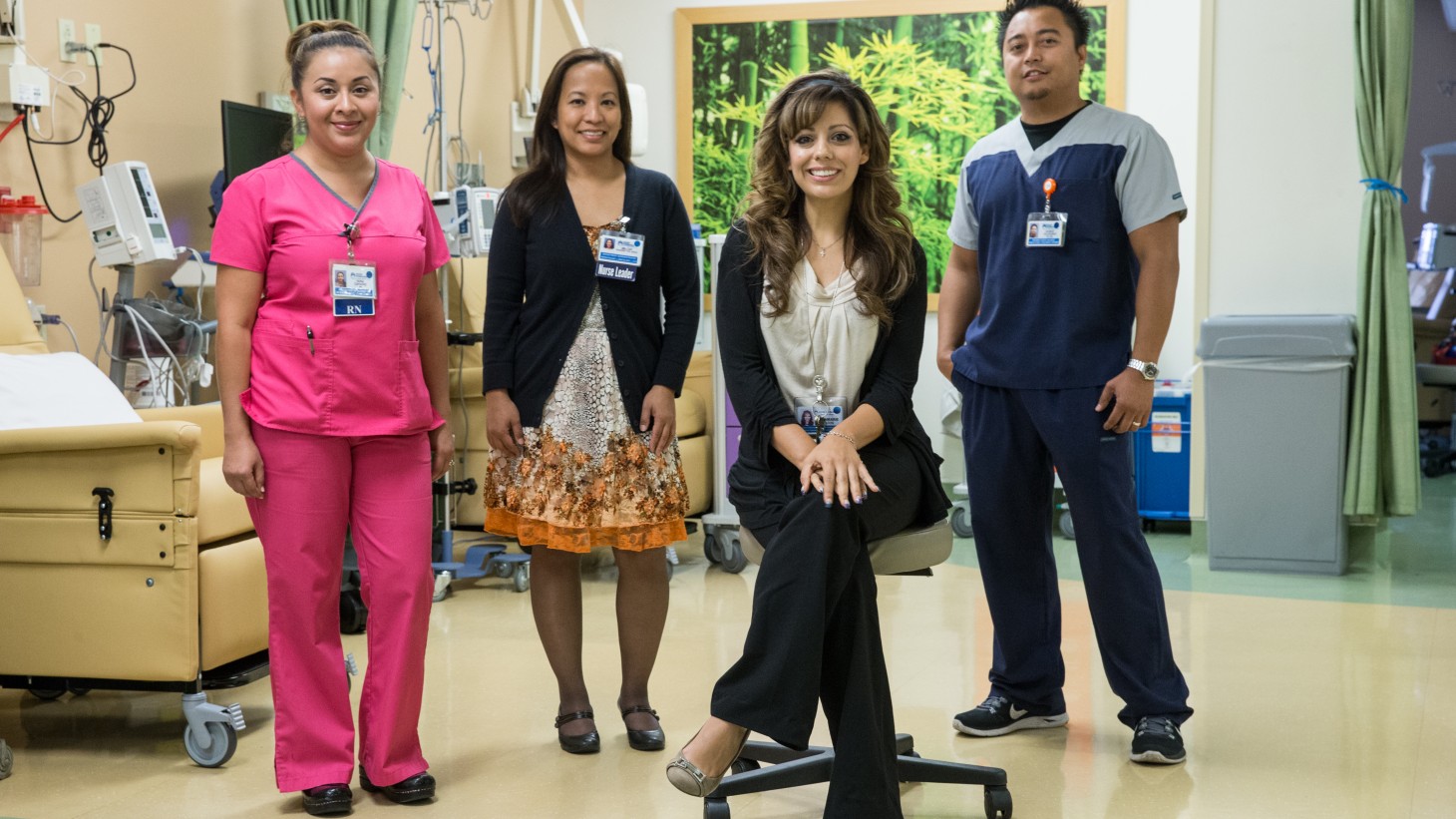Workforce of the Future
Helping Teams Understand Their Value

Marin (seated) surrounded by members of the Oncology UBT: Rosa Camacho, RN, Melody Navarro, RN, and Gilbert Villadores, RN (from left to right). Camacho and Villadores are UNAC/UHCP members and Navarro is the department administrator.
Peer advice from a union partnership representative
As a union partnership representative (UPR) from UFCW Local 770, Annamarie Marin helps support 72 unit-based teams at the West Los Angeles Medical Center. Last year, she helped the Oncology team overcome low morale to move from Level 2 to Level 4—and it’s now on the cusp of achieving Level 5. Marin recently was interviewed about her role as a UPR by LMP Communications Manager Sherry Crosby.
Q. What experiences helped prepare you for your position?
A. I have been part of UBTs since 2005. I started as a co-lead and then became an executive sponsor. This experience helped me tremendously, because I can relate to the teams on a personal level. I have been in the exact same place, dealing with similar challenges.
Q. What is your approach to working with teams?
A. Some teams need team-building exercises, while others need to learn to trust one another and share information on projects. Starter teams don’t know how to create agendas or structure meetings, so I help facilitate their meetings. The most important thing is making sure I’m available and that teams have what they need to succeed.
Q. What early challenges did the Oncology team face?
A. They were struggling with membership involvement and morale was low. Nobody wanted to participate in meetings.
Q. How did you help the team succeed?
A. I helped staff members understand that the UBT is not there to add work to their plate. Eventually, we got a group to participate in team meetings.
We went through different trainings and started on small projects. First, they focused on staff morale. Staff members practiced expressing appreciation for each other until it became part of the team's culture. Then they moved to an affordability project. That was a pivotal point in that team’s development, because the idea came from a labor partner.
It shows team members are involved in decision making and contributing to the department’s success.
Q. What was key to the team’s success?
A. I helped the team members understand their work through a different lens—what the function of a UBT is, and their role in it. They realized they have a great department and an engaged manager. It was really about helping them understand their value to each other.

With the help of Annamarie, our team moved from what looked like a Level 0 to a Level 4.
Starting From Ground Zero:
West Los Angeles UPR gives team a boost
Melody Navarro, RN, doesn’t have fond memories of her first months as management co-lead of the West Los Angeles Oncology UBT.
No one wanted to attend meetings or join the team, which represents two departments—the Oncology/Hematology Clinic and the Ambulatory Treatment Center. Navarro manages both departments, which offer infusion services to different patient populations.
Accustomed to working with a high-level team in her former department, Navarro was dismayed by what she saw. Uncertain how best to proceed, she reached out to Annamarie Marin, a union partnership representative.
In need of help
Sometimes Marin works with teams because she’s assigned to work with them. Other times, she is responding to those who reach out and ask for help.
“The UBT was not a functioning UBT,” says Navarro. “With the help of Annamarie, our team moved from what looked like a Level 0 to a Level 4.”
The department did not have a strong partnership culture before Navarro came on board, says Rosa Camacho, RN, the team’s union co-lead and a member of UNAC/UHCP.
“We were very understaffed and we lacked teamwork,” Camacho recalls. “Everyone was doing their own job.”
Shared understanding
Marin helped the 28-member team with some core pieces that all successful unit-based teams need to have in place, including a shared understanding of their roles and responsibilities. She attended team meetings and trained employees how to use the UBT Tracker, the online tool that teams use to report their work.
She also worked with them on how to incorporate the Rapid Improvement Model into their work and use small tests of change to improve performance. That led to a successful project last year that streamlined central line supplies. Instead of ordering expensive kits, now the department orders only what it needs, saving more than $2,600 yearly.
“She’s very hands-on and patient,” says Camacho. “She’s always around whenever we need help.”
